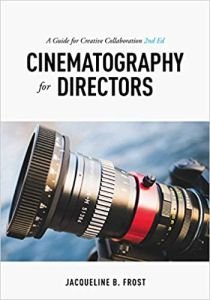Cinematography For Directors, 2nd Ed. by Jacqueline B. Frost (book review).
The release of a second edition of Jacqueline B. Frost’s book, ‘Cinematography For Directors’ is, as she explains, to covers changes and development in digital filming. Rather interestingly, the cinematographer isn’t necessarily the cameraman but there does appear grey areas between the three roles.
Frost also notes that things can be more effective when all three people can speak the same language which helps in the resolution of solutions in terms of their particular jobs. The director’s concern is telling the story and motivating the actors. The cinematographer ensures the mood of the setting in colour choices and helping the director is done as a visual interpreter.
Once I started digging into this book, my attention was again rapt. Even if you don’t want to make films, it gives some interesting insight into the subtilities of filming in colour, lighting and lens filters that subconsciously affect how you watch a film. In many respects, this is invariably invisible to the normal viewer but contributes to the experience you get from a film.
If you’re doing your own films, the use of the right lenses and how to get the best use out of them should raise the level of your own direction. It’s also rather interesting seeing how much cinematographers make use of paintings and photographs to show their directors the kind of mood they are looking for with the application of chiaroscuro. The examination of director’s viewfinders, the gadget you often see around a director’s neck and how a toilet roll tube can be just as effective. There is even a look at storyboarding’s virtues and its approach will be of use to comicbook artists.
There are some useful tips for other creative skills here as well. Certainly the use of colour and light will give some interest thoughts to painters who want to experiment with their choices. More so as I hadn’t realised just how much of a blue tinge film picks up. There’s a lot of coloured photos demonstrating this from a lot of current films. There’s also a briefing of a lot of example films and I was noting a lot that I hadn’t seen as well. Although the history of American film companies is brief, the emphasis on how they centred on particular films will make you think. In many respects, this move away from technicality talk geared me back stronger with camera equipment and the associated photos give the ideal reference.
Obviously, there is a look at the contrasts between digital and film and if you are planning to make any sort of movie, learning about the variety of cameras will guide you to your wants. The most expensive is not always the best choice when you rent your cameras.
Although the opening chapters felt a little slow, once past them I got up to speed and adding more information to my learning curve. There are so many areas where film and other arts cross over that this makes books like this useful to explore angle and mood and that can only improve my own skills. The insights from the cinematographers which if you are a new director will guide you to the choices you need to look at when selecting these people.
The book is also currently available both sides of the pond that should make it easier for you to get a copy in the lockdown and get the necessary practice in refining your own skills.
GF Willmetts
April 2020
(pub: Michael Wiese Productions, 2020. 279 page illustrated enlarged paperback. Price: $35.95 (US), £22.50 (UK). ISBN: 978-1-61593-274-0)
check out website: www.mwp.com

